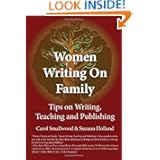I ran across a new book at my local library a few weeks ago. It’s an anthology entitled Women Writing On Family: Tips on Writing, Teaching and Publishing. It’s edited by Carol Smallwood and Suzann Holland and published by The Key Publishing House, Inc. of Toronto, Canada (www.thekeypublish.com). There are fifty-five chapters in eight parts including Personal and Legal Issues about Family Topics; Making the Most of Your Family Experience; Exploring Family in a Variety of Genres; and Publishing, Marketing & Promoting.
In the introduction, the editors quote a Proust passage from The Remembrance of Things Past which says: “When nothing else subsists from the past, after the people are dead, after the things are broken and scattered, the smell and taste of things remain poised a long time, like souls bearing resiliently, on tiny and almost impalpable drops of their essence, the immense edifice of memory.” The editors remark that for many women, their memory essentially is through family and note that Virginia Woolf once said, “We think back through our mothers if we are women.”
Some of the contributions I enjoyed were:
#15 Making Up Grandma: How to Blend History and Imagination Into Powerful Family Narratives by Lela Davidson. The first sentence in her chapter says, “The best family histories are rich in detail.”
#17 Telling Our Truth: Writing the Legacy of the Dead by Carol Hawkins who poses several questions to serve as guideposts for writing and suggests that we be careful in choosing which stories to tell.
#26 Mothers and Daughters: Telling Shared Stories by Diane LeBlanc who offers suggestions on writing shared stories in ways that both reveal and respect and reminds us that when we tell our stories, we tell our truth, not necessarily the truth.
#32 Creating the Fictional Family: No Character is an Island by Yelizaveta P. Renfro. The contributor of this article suggests creating a family history and historical setting for characters in a fictional piece.
#33 From Memoir to Fiction by Dahlma Llanos-Figueroa. This contributor offers several suggestions for mapping your own journey of turning family stories into universal truths of a literary novel.
#41 The Roles of Women in Narrative by Mary Rice. This writer discusses that women are often the keepers of experience and keepers of humanity and as such are at the forefront of stories that create a coherent sense of community among characters.
There are also practical chapters for finding online writing niches and the like as well, but I found the above most useful in writing family history. If you get a chance, I highly recommend this book.
In the introduction, the editors quote a Proust passage from The Remembrance of Things Past which says: “When nothing else subsists from the past, after the people are dead, after the things are broken and scattered, the smell and taste of things remain poised a long time, like souls bearing resiliently, on tiny and almost impalpable drops of their essence, the immense edifice of memory.” The editors remark that for many women, their memory essentially is through family and note that Virginia Woolf once said, “We think back through our mothers if we are women.”
Some of the contributions I enjoyed were:
#15 Making Up Grandma: How to Blend History and Imagination Into Powerful Family Narratives by Lela Davidson. The first sentence in her chapter says, “The best family histories are rich in detail.”
#17 Telling Our Truth: Writing the Legacy of the Dead by Carol Hawkins who poses several questions to serve as guideposts for writing and suggests that we be careful in choosing which stories to tell.
#26 Mothers and Daughters: Telling Shared Stories by Diane LeBlanc who offers suggestions on writing shared stories in ways that both reveal and respect and reminds us that when we tell our stories, we tell our truth, not necessarily the truth.
#32 Creating the Fictional Family: No Character is an Island by Yelizaveta P. Renfro. The contributor of this article suggests creating a family history and historical setting for characters in a fictional piece.
#33 From Memoir to Fiction by Dahlma Llanos-Figueroa. This contributor offers several suggestions for mapping your own journey of turning family stories into universal truths of a literary novel.
#41 The Roles of Women in Narrative by Mary Rice. This writer discusses that women are often the keepers of experience and keepers of humanity and as such are at the forefront of stories that create a coherent sense of community among characters.
There are also practical chapters for finding online writing niches and the like as well, but I found the above most useful in writing family history. If you get a chance, I highly recommend this book.

That sounds like a great book. I am blessed to have a mother who is a writer and who loves telling our family stories.
ReplyDeleteYou're right, Jay, you are blessed that your mother is a writer and loves telling the family stories! Thanks for your comment.
DeleteI could relate to so much of your extracts - how true that "The best family histories are rich in detail". So much is out there on on researching your family history, but so much less on what to do with all the infor. you gather and how to write it up. This publication sounds as if it fills a major gap.
ReplyDeleteThanks for letting me know you could relate to these, Susan. Although this publication is not exclusively for family history writing, I think it does have some great contributions that can be helpful with that process. Maybe someone else has more information on other publications in a similar vein about what to do with what you find and how to write it. Please feel free to comment!
Delete